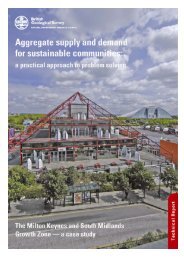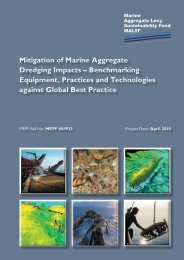creating environmental improvements through biodiversity
creating environmental improvements through biodiversity
creating environmental improvements through biodiversity
You also want an ePaper? Increase the reach of your titles
YUMPU automatically turns print PDFs into web optimized ePapers that Google loves.
Sustainable Aggregates Creating Environmental Improvements <strong>through</strong> Biodiversity<br />
of those trying to restore polluted sites.<br />
The U.S. Forest Service, the Bureau of Land Management, EPA and Trout Unlimited have partnered to bypass<br />
the legal limitations and enable a wider programme of cleanup of affected waterways. On federal lands, the<br />
government can shoulder liability, enabling contractors and non-governmental organizations to do the work.<br />
On private lands, Trout Unlimited and EPA are trying to negotiate further liability shields to protect the<br />
conservation group if it cleans up old mines on private lands without clear owners. This could be important<br />
in expanding the restoration work in the region, as developing liability shields could encourage further<br />
private cleanups. But the best mechanism would be legislation at a congressional level, which still needs to be<br />
addressed to make additional partnerships possible.<br />
Technical Innovation<br />
Some sites in the region offered unique challenges due to the nature of the waste material, high altitudes,<br />
extremely limited access, steep terrain and cost limitations. Trout Unlimited has used technical assistance<br />
from many organizations, most recently EPA, to test cutting-edge technologies without fear of repercussions.<br />
Each mine site is different, often requiring a suite of approaches to deal with issues and site-specific<br />
conditions. Some abandoned mine cleanup tactics (especially those directed at controlling soil erosion and<br />
sediment loss) use simple, low-tech ideas such as surface topography restoration, stream channel restoration<br />
and habitat restoration. Other approaches are very complex and expensive, necessitating engineering designs<br />
and extensive planning. Also the methods will vary widely in difficulty, cost and issues related to liability.<br />
Abandoned mine cleanup can be classified into three categories: restoration, reclamation and remediation.<br />
Restoration typically means putting the site back to its natural condition as much as possible. Reclamation<br />
usually involves a series of steps to address sediment control, such as regrading and revegetation.<br />
Remediation is often used by regulatory agencies to describe the work at a mine site to reduce risks<br />
resulting from chemical or physical hazards. Remediation can also involve either passive or active treatment<br />
(although passive treatment is somewhat of a misnomer in that all treatment requires operation and<br />
maintenance).<br />
COMBINED TECHNICAL AND PARTNERSHIP APPROACH: ANIMAS RIVER<br />
WATERSHED, COLORADO<br />
The Place: The Upper Animas Watershed is located in the San Juan Mountains of southwestern Colorado<br />
within the Colorado mineral belt. Over the past 150 years the upper portion of the watershed near<br />
Silverton was heavily mined for gold, silver and lead. With more than 2,000 abandoned mines and no current<br />
mining industry, this community is one of the poorest in Colorado. Its only form of economic development<br />
is tourism. The most significant aspect of this project is not just the complexity of the problem but the<br />
commitment of the community to get things done.<br />
The Problem: From its source tributaries in and around Silverton, Colorado, to its confluence with<br />
the San Juan River, the Animas River is tainted with heavy metals and acid load. The river contains traces<br />
of aluminium, cadmium, iron, copper, magnesium, lead and zinc, among others. Some of the load can be<br />
attributed to natural leaching of the mineralized bedrock. Abandoned mine sites (mine adit drainages, waste<br />
rock piles, tailings piles and stream deposited wastes) are the most significant threat to the river’s quality,<br />
based on extensive water monitoring. Iron and manganese are due primarily to natural mineralization,<br />
whereas copper, lead, zinc and cadmium resulted primarily from human impacts exposing new mineralized<br />
surfaces to dissolution.<br />
The Partners: The Animas River Stakeholders Group was formed to galvanize restoration efforts. In<br />
102

















